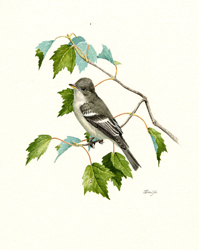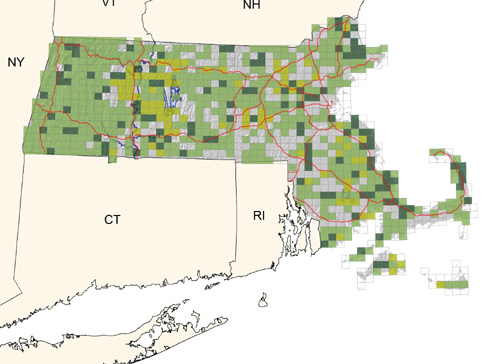Breeding Bird Atlases (BBA)
Find a Bird - BBA1
Breeding Bird Atlas 1 Species Accounts
Eastern Wood-Pewee
Contopus virens
Egg Dates
June 8 to July 25
Number of Broods
one

The Eastern Wood-Pewee is the common forest flycatcher of Massachusetts. It breeds in deciduous and mixed woodland throughout the state and in the Pitch Pine barrens of the coastal plain. It also nests in orchards, parks, and other situations in which there is an abundance of mature trees. Its status has apparently remained constant throughout the historical period; though, of course, the total population has fluctuated in response to the clearing of land for agriculture through the midnineteenth century and the subsequent reforestation. Bent, writing in the early 1940s, stated that it had decreased markedly in eastern Massachusetts “during the past 20 years,” but this observation is not substantiated elsewhere.
Pewees arrive on their breeding grounds with the first major songbird wave in mid-May, and migration continues throughout the month, typically peaking in the third week. Despite their general abundance as breeders, they do not occur in large numbers at coastal migrant traps; the maximum number reported together on spring migration is 10.
A whistled, ascending pee-a-wee uttered from amidst concealing foliage is a quintessential sound of the woodlands of eastern North America. In fact, in summer a pewee’s presence is far more likely to be detected by its song than by glimpsing the drab little form of the bird itself. The quality has been described as both plaintive and cheerful, depending on the mood of the listener. An alternate song is a down-slurred pee-ur. Pewees also make chittering sounds near the nest. The standard call is a soft chip without any striking quality. Pewees have also been seen to engage in ecstasy or emotion-release songs, often accompanied by aerobatics. Begging young produce a squeaking call.
The pewee’s courtship ritual is not very elaborate or distinctive. Audubon described a butterflylike nuptial flight, and other observers report increased agitation and aggression during the courtship period, with flight pursuit of females by males that are accompanied by chattering call notes.
This flycatcher typically nests at moderate height, 15 to 50 feet, in the shade of the forest canopy. The nest is a notably shallow, thick-walled cup, about 3 inches in diameter, placed on a horizontal limb. It is constructed of bark strips and other plant fibers and lined with finer materials consisting of plant down, animal hair, etc. The exterior is heavily encrusted with lichens and this, together with its low profile, disguises it as a bump on a limb from below. Nests in Massachusetts Pitch Pine forests are said to be more conspicuous, but they closely resemble the large clumps of lichens that typically adorn branches in this habitat. Other nests from the southeastern part of the state were in apple trees in old orchards (ACB). A nest in Dartmouth was 15 feet up in an oak (CNR).
The two to four (average three) eggs are cream to white, usually wreathed at the larger end with lavender to brown blotches and speckles. Clutch sizes for 3 Massachusetts nests were three eggs (2 nests) and four eggs (1 nest) (DKW, CNR). Incubation, exclusively by the female, takes 12 to 13 days. The young leave the nest 15 to 18 days after hatching. A nest in Gardner contained young on July 8 (TC). Adults feeding fledglings in the state have been reported from July 22 to September 6. On the latter date, a pair was observed feeding two large fledglings in Southbridge (Meservey). The speculation by Forbush that pewees may occasionally be double brooded in southern New England is unconfirmed, but the July egg dates and late records for dependent young indicate that this may sometimes occur.
Parasitism by Brown-headed Cowbirds is recorded but is apparently infrequent. The fall migration of the Eastern Wood-Pewee in Massachusetts occurs principally between late August and early October. As in the spring, they are thinly scattered, with numbers seen seldom exceeding 15.
The species winters from Nicaragua south through Colombia and Venezuela to Bolivia and western Brazil. In the tropics, it inhabits semiopen country, including cleared agricultural lands and shaded plantations, from the lowlands to about 5,000 feet.
Map Legend and Data Summary
Atlas 1 data collected from 1975-1979


Note: common in woodlands throughout the state; especially common in Pitch Pines of the southeastern coastal plain
Christopher W. Leahy



